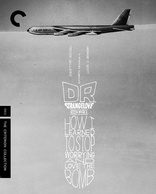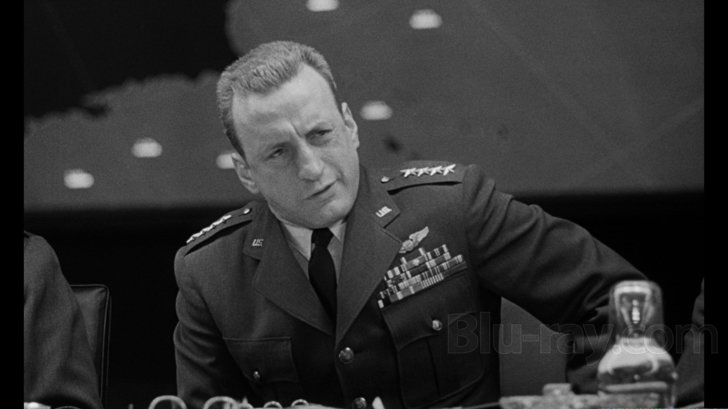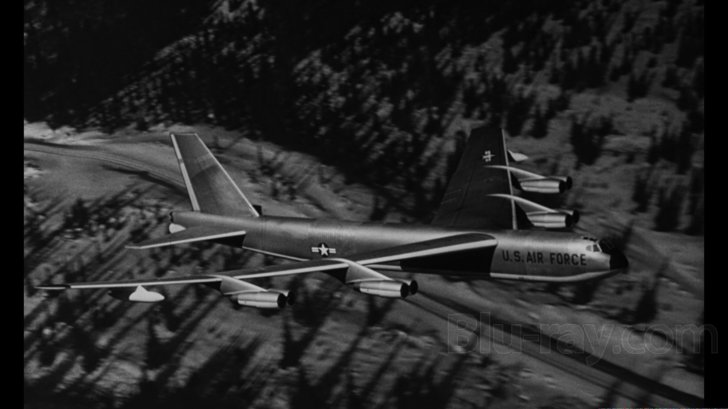Dr. Strangelove or: How I Learned to Stop Worrying and Love the Bomb Blu-ray Movie
HomeDr. Strangelove or: How I Learned to Stop Worrying and Love the Bomb Blu-ray Movie 
Criterion | 1964 | 95 min | Rated PG | Jun 28, 2016
Movie rating
8.6 | / 10 |
Blu-ray rating
| Users | 4.8 | |
| Reviewer | 5.0 | |
| Overall | 4.8 |
Overview
Dr. Strangelove or: How I Learned to Stop Worrying and Love the Bomb (1964)
After a psychotic Air Force general unleashes an ingenious, foolproof and irrevocable scheme sending bombers to attack the Soviet Union, the U.S. President phones the Soviet premier in a desperate effort to save the world.
Starring: Peter Sellers, George C. Scott, Sterling Hayden, Keenan Wynn, Slim PickensDirector: Stanley Kubrick
| Drama | 100% |
| Dark humor | 27% |
| War | 22% |
| Imaginary | 10% |
Specifications
Video
Video codec: MPEG-4 AVC
Video resolution: 1080p
Aspect ratio: 1.66:1
Original aspect ratio: 1.66:1
Audio
English: DTS-HD Master Audio 5.1 (48kHz, 24-bit)
English: LPCM Mono (48kHz, 24-bit)
Subtitles
English SDH
Discs
50GB Blu-ray Disc
Single disc (1 BD)
Playback
Region A (locked)
Review
Rating summary
| Movie | 4.0 | |
| Video | 5.0 | |
| Audio | 5.0 | |
| Extras | 5.0 | |
| Overall | 5.0 |
Dr. Strangelove or: How I Learned to Stop Worrying and Love the Bomb Blu-ray Movie Review
Reviewed by Dr. Svet Atanasov July 5, 2016Nominated for four Oscar Awards, Stanley Kubrick's "Dr. Strangelove or: How I Learned to Stop Worrying and Love the Bomb" (1964) arrives on Blu-ray courtesy of Criterion. The supplemental features on the disc include original trailers for the film; excerpts from an archival interview with Stanley Kubrick; new interview with cinematographer and camera innovator Joe Dunton; new interviews with scholars Mick Broderick and Rodney Hill; four short documentaries; and a lot more. The release also arrives with an illustrated booklet featuring an essay by scholar David Bromwich and an article by screenwriter Terry Southern on the making of the film. In English, with optional English SDH subtitles for the main feature. Region-A "locked".

Have you ever seen a commie drink a glass of water?
Stanley Kubrickís Dr. Strangelove or: How I learned to Stop Worrying and Love the Bomb should feel awfully dated now. It emerged at a time when the world was divided by two ideologies that made people incredibly suspicious of each other. As these ideologies became more polarizing the mistrust also grew bigger and eventually evolved into pure animosity that led to the infamous Cuban Missile Crisis. A gigantic tragedy was narrowly avoided, but the feeling that something terrible could still happen remained. Kubrickís film essentially channels this fear.
The world is different now. It is easier for people and governments to communicate and a lot has been done to avoid global military conflicts. Today most people genuinely believe that the world is indeed a safer place. But, is it really?
I am not convinced. While I was watching Dr. Strangelove or: How I learned to Stop Worrying and Love the Bomb last week I just could not stop thinking of the downing of the Russian jet on the Turkey-Syria border last year and the serious international crisis it created. On November 24, 2015, Turkey shot down a Russian Su-24 because, according to the Turkish government, it violated its airspace. Russia immediately dismissed the official statement of the Turkish government and vowed to respond. The announcement triggered a series of secret diplomatic meetings because Turkey is a member of NATO and can invoke Article 5 which would force the alliance to protect it if Russia did indeed choose to respond with military force. The international media did some pretty creative coverage that downplayed the situation, but I assure you that a lot of very important people, including some right here in the U.S., became very, very nervous. A disaster was avoided, but Russiaís relationship with Turkey and NATO remains tense.
Kubrickís film offers a similar scenario involving the two biggest Cold War powers, the U.S. and the U.S.S.R. Basically, a communication error triggers a series of terrible responses from the two powers that create a terrible situation which they canít control. Before the final credits roll there is a lot of finger-pointing and debating of what-if scenarios that are essentially inspired by the same awful logic that continues to poison the minds of many modern political and military leaders.
Kubrick does some interesting twists that make the whole thing look quite ridiculous, but it is very easy to tell that he was seriously concerned about the direction the world was heading during the early 1960s. A lot of people find his film hilarious -- and it has to be said that some of Peter Sellersí improvisations can be quite entertaining -- but I find it rather disturbing because it gets so many things right. The dangerous mistrust, the misunderstood patriotism, and the paranoia that are responsible for a lot of the Ďhumorí are not exactly some odd Cold War relics.
Gilbert Taylorís black-and-white cinematography and some of the rougher spots -- the original negative was destroyed at the time of the filmís theatrical release -- reveal that Dr. Strangelove or: How I learned to Stop Worrying and Love the Bomb comes from a different era, but I donít think that it feels dated. It is a very, very relevant reminder that as long as there are powerful ideological rivals the threat of nuclear holocaust remains.
Dr. Strangelove or: How I Learned to Stop Worrying and Love the Bomb Blu-ray Movie, Video Quality 

Presented in an aspect ratio of 1.66:1, encoded with MPEG-4 AVC and granted a 1080p transfer, Stanley Kubrick's Dr. Strangelove or: How I Learned to Stop Worrying and Love the Bomb arrives on Blu-ray courtesy of Criterion.
The following text appears inside the tiny book provided with this Blu-ray release:
"Because of overprinting and damage created at the time of its theatrical release, Dr. Strangelove or: How I Learned to Stop Worrying and Love the Bomb was destroyed at the laboratory fifty years ago. As a result, a combination of elements, including 35mm fine-grain master positives, duplicate negatives, and prints, were used for this digital transfer, which was created in 4K resolution on an Oxberry wet-gate film scanner at Cineric in New York in 2004. Given the condition of the many elements; the fact that they represented different manufacturing generations from the original camera negative, resulting in wide variations in density and contrast; and the need to maintain the filmmakers' aesthetic intentions, it was determined that the only way to restore the film properly was in a full 4K digital space. Daniel DeVincent, Cineric's director of digital restoration, created lookup tables designed to optimize the scanner for each element and achieve the dynamic range of 35mm film. Under the supervision of Grover Crisp, initial color correction was carried out by DeVincent, with additional color correction done by Scott Ostrowsky at Technicolor and Colorwors in Los Angeles. Thousands of instances of dirt, debris, scratches, splices, warps, jitter, and flicker were manually removed by Cineric using DaVinci's Revival.
The original monaural soundtrack and the alternate 5.1 surround mix were remastered from the best surviving optical tracks at Chace Audio by Deluxe, under Crisp's supervision. Additional restoration was undertaken by the Criterion Collection using Pro Tools and iZotope RX4.
Transfer supervisor: Grover Crisp.
Colorist: Daniel DeVincent/Cineric, New York; Scott Ostrowsky/Technicolor and Colorworks, Los Angeles."
I believe that the restoration and reconstruction of Dr. Strangelove or: How I Learned to Stop Worrying and Love the Bomb was the very first full 4K job that Sony Pictures completed. It was initially introduced on Blu-ray in 2009 (you can see our listing and review of the first release here). I think that the end result is quite spectacular. Indeed, despite the fact that multiple elements were accessed and re-conformed density fluctuations are minimal and fluidity remains consistent throughout the entire film. Contrast levels are also well balanced -- there are no unnatural spikes or drops that affect negatively the overall image composition. Grain is well distributed and resolved. There are a few sequences where minor fluctuations in terms of exposure can be spotted, but as mentioned earlier, fluidity isn't impacted. Depth and clarity are very good. Also, there are plenty of healthy nuances -- with balance between grays and whites being particularly impressive -- that further support the film's already very convincing organic appearance. Image stability is very good. Lastly, there are no distracting large cuts, debris, chemical stains, damage marks, or warped frames to report in our review. My score is 4.75/5.00. (Note: This is a Region-A "locked" Blu-ray release. Therefore, you must have a native Region-A or Region-Free player in order to access its content).
Dr. Strangelove or: How I Learned to Stop Worrying and Love the Bomb Blu-ray Movie, Audio Quality 

There are two standard audio tracks on this Blu-ray release: English LPCM 1.0 and English DTS-HD Master Audio 5.1. Optional English SDH subtitles are provided for the main feature.
I viewed the film with the LPCM 1.0 track and did only a few quick comparisons with the DTS-HD Master Audio 5.1 track. Depth and clarity are very good. I also paid close attention to see how balance is handled, though the film's original sound design does not promote any major fluctuations. The mid- and high-frequencies are excellent; there are no unnatural fluctuations and background hiss is never an issue of concern. The dialog is always crisp, clean, stable, and very easy to follow.
On the 5.1 track separation is easily noticeable during select sequences, but the overall dynamic effect I think is unlikely to impress fans of the film. My preference is to view the film with the Mono track, but you should experiment with both tracks and see which one you like better.
Dr. Strangelove or: How I Learned to Stop Worrying and Love the Bomb Blu-ray Movie, Special Features and Extras 

- Stanley Kubrick - presented here is a collection of short excerpts from an archival interview with Stanley Kubrick conducted by Jeremy Bernstein. The director quickly explains how the idea for Dr. Strangelove or: How I learned to Stop Worrying and Love the Bomb emerged and discusses the practice of directing (with comments about writing and editing). The interview was conducted on November 27, 1966. In English, not subtitled. (4 min, 1080p).
- Mick Broderick - in this new video program, film scholar Mick Broderick (author of Reconstructing "Strangelove") discusses the evolution of Stanley Kubrick's career and the production history of Dr. Strangelove or: How I learned to Stop Worrying and Love the Bomb, which was the first film the dierctor also produced. There are also some very interesting comments addressing Peter Sellers' performance and improvisations. The program was created by Criterion in 2016. In English, not subtitled. (20 min, 1080p).
- The Art of Stanley Kubrick - in this archival program, critic Alexander Walker, cinematographer Gilbert Taylor, biographer John Baxter, executive producer Lee Minoff, and actor James Earl Jones, amongst others, discuss Stanley Kubrick's early work as a photographer, his transition to the film industry, and some of the qualities that defined his style. The program was produced in 2000. In English, not subtitled. (14 min, 1080i).
- Joe Dunton and Kelvin Pike - in this brand new video interview, cinematographer and camera innovator Joe Dunton and camera operator Kelvin Pike discuss the creative philosophy and working methods of Stanley Kubrick. There are also specific comments that address the use of light and darkness in Dr. Strangelove or: How I learned to Stop Worrying and Love the Bomb as well as the framing of key sequences. The interview was conducted exclusively for Criterion in 2016. In English, not subtitled. (13 min, 1080p).
- Inside "Dr. Strangelove" - this archival documentary focuses on the production history of Dr. Strangelove or: How I learned to Stop Worrying and Love the Bomb and its unusual narrative. Included in it is archival material (stills, clips, film footage) and clips from interviews with producer James B. Harris, film critic Alexander Walker, executive producer Lee Minoff, and production designer Ken Adam, amongst others. The documentary was produced in 2000. In English, not subtitled. (47 min, 1080i).
1. Fear into lunacy
2. Building the sets
3. High altitudes
4. Casting
5. Lawsuit
6. Titles and music
7. Pie fight
8. Cutting-edge
- Richard Daniels - in this new video interview, Richard Daniels, senior archivist at the Stanley Kubrick Archive and coeditor of the book Stanley Kubrick: New Perspectives, discusses the creative personality of Stanley Kubrick, his interest in details, the early version of the script for Dr. Strangelove or: How I learned to Stop Worrying and Love the Bomb and some of the changes that were made later on, and different notes and descriptions from Stanley Kubrick that are kept in the archive. The interview was conducted exclusively for Criterion in 2016. In English, not subtitled. (15 min, 1080p).
- David George - in this new video program, David George, the son of novelist Peter George, who wrote Red Alert, the book on which Dr. Strangelove or: How I learned to Stop Worrying and Love the Bomb is based, discusses his father's personal and professional relationships with Stanley Kubrick, the development of the script for the film, the short story that introduced the character of Dr. Strangelove, the film's unique sense of humor, etc. The program was produced exclusively for Criterion in 2016. In English, not subtitled. (11 min, 1080p).
- No Fighting in the War Room - in this archival program, former secretary of defense Robert McNamara, journalist Bob Woodward, critic Roger Ebert, producer James B. Harris, and director Spike Lee, amongst others, discuss the socio-political environment in which Dr. Strangelove or: How I learned to Stop Worrying and Love the Bomb emerged and its critical reception. The program was produced in 2004. In English, not subtitled. (31 min, 1080i).
1. Cold and hot
2. Deterrence
3. Accidents
4. In the beginning
5. All-out attack
- Best Sellers - this archival video program focuses on Peter Sellers' brilliant contribution to Dr. Strangelove or: How I learned to Stop Worrying and Love the Bomb. Included in it are clips from interviews with critic Roger Ebert, Michael Palin, Shirley MacLaine, Sir David Frost, and director Richard Lester, amongst others. The program was produced in 2004. In English, not subtitled. (19 min, 1080i).
- Rodney Hill - in this new video interview, film scholar Rodney Hill (contributor, The Stanley Kubrick Archives) discusses the mythological qualities of Dr. Strangelove or: How I learned to Stop Worrying and Love the Bomb as well as some of the most common archetypes in the film. The interview was conducted exclusively for Criterion in 2016. In English, not subtitled. (18 min, 1080i).
- George C. Scott and Peter Sellers - presented here are archival interviews with actor George C. Scott and Peter Sellers which were shot on the set of Dr. Strangelove or: How I learned to Stop Worrying and Love the Bomb in 1963. The interviews were used by Columbia Pictures to promote the film. (The clip with Peter Sellers is incredibly funny). In English, not subtitled. (8 min, 1080i).
- Today - presented here is a short excerpt from an episode of NBC's Today in which critic Gene Shalit interviews Peter Sellers. The episode was broadcast on March 12, 1980. In English, not subtitled. (5 min, 1080i).
- Exhibitor's Trailer - the notorious long trailer for Dr. Strangelove or: How I learned to Stop Worrying and Love the Bomb with audio descriptions by Stanley Kubrick. The trailer features uncut material with multiple angles of the main characters. In English, not subtitled. (17 min, 1080p).
- Theatrical Trailer - original theatrical trailer for Dr. Strangelove or: How I learned to Stop Worrying and Love the Bomb. In English, not subtitled. (4 min, 1080p).
- Booklet - an illustrated booklet featuring an essay by scholar David Bromwich and a 1994 article by screenwriter Terry Southern on the making of the film.
Dr. Strangelove or: How I Learned to Stop Worrying and Love the Bomb Blu-ray Movie, Overall Score and Recommendation 

I think that it is rather odd that so many people like Dr. Strangelove or: How I learned to Stop Worrying and Love the Bomb because it is a great comedy. I never thought that it was a particularly funny film. I think that it works because the fear and paranoia that permeate it are effectively used to deliver some very serious warnings. Criterion's new Blu-ray release of the film will likely remain its definitive presentation on the home video market. It is sourced from Sony's excellent 4K restoration and reconstruction of the film and has a tremendous amount of informative supplemental features. HIGHLY RECOMMENDED.
Other editions
Dr. Strangelove or: How I Learned to Stop Worrying and Love the Bomb: Other Editions

Dr. Strangelove or: How I Learned to Stop Worrying and Love the Bomb
45th Anniversary Special Edition
1964

Dr. Strangelove or: How I Learned to Stop Worrying and Love the Bomb
1964

Dr. Strangelove or: How I Learned to Stop Worrying and Love the Bomb 4K
1964
Similar titles
Similar titles you might also like

Fail Safe
1964

Paths of Glory 4K
1957

5 Days of War
2011

The Great Dictator
1940

Generation Kill
2008

Lions for Lambs
2007

Breaker Morant
1980

The Thin Red Line
1998

Apocalypse Now 4K
Final Cut | 40th Anniversary Edition
1979

The Day After
1983

Full Metal Jacket 4K
1987

The Green Berets
1968

The Deer Hunter 4K
Collector's Edition
1978

Che: Part Two
2008

Punishment Park
1971

Coriolanus
2011

Cross of Iron
1977

The Big Parade
Warner Archive Collection
1925

Jarhead
2005

M*A*S*H
1970